Table of Contents
ToggleIntroduction
MSI's K7 Master is a AMD 760 based motherboard, that is clearly targeted towards workstation users. In the -S variant, it features an onboard U160 SCSI Adaptec chip and both the Master and the Master-S offer an AGP Pro port with an additional 4-pin 12 V power connector.
On prototype boards, there were four memory slots present, but this was dropped very early. Here is an announcement from December of 2000, with all 4 slots present: https://www.pcstats.com/articles/503/5.html
And in this review from April of 2001, there are only two of them left, even though the board is still a Rev 0D pre-production unit (which is mentioned one page later): http://www.thg.ru/mainboard/20010409/kt266-02.html
My K7 Master Rev 1.1 arrived in really bad shape. With one capacitor already missing completely and several others crooked and blown, one could really tell it did its job until the bitter end. But after a complete recap and with the latest BIOS installed, it is fully operational again.
So let's put MSI's workhorse to the test, and see if it values its second life 😉
Gallery
Specifications and Features
Chipset:
- AMD 761 Northbridge
- VIA 686B Southbridge
CPU Support (with latest BIOS):
- Athlon Thunderbird (ALL, if board revision is 1.1; 1.0: only FSB100 models)
- Athlon XP Palomino (ALL, if board revision is 1.1)
- Duron Spitfire (ALL)
- Duron Morgan (ALL, if board revision is 1.1; 1.0: only up to Duron 1200 MHz)
Memory Support:
- 2 DDR DIMM slots, up to 2 GB total
Expansion Slots:
- 1x AGP Pro slot (1,5V) up to 4x
- 5x PCI slots
- 1x CNR slot
Connectors (internal):
- 2x IDE (UDMA100)
- 1x Floppy
- 2x USB 1.1
- 3x 3-pin fan connectors total (1x CPU, 2x chassis)
Connectors (external):
- 2x PS/2
- 2x COM/RS-232
- 1x Parallel Port
- 2x USB 1.1
- 3x 3,5" Audio Jacks (Line-Out, Line-In, Mic)
- Gameport
You might have noticed, that I didn't mention the audio chipset specifically, as I think far better solutions than the old onboard chipsets are readily available for little money. Very commonly recommended are the Creative Soundblaster Live! cards for example, which offer fantastic compatibility with our beloved old games and sound far better than any onboard solution of that era.
I also don't list (from a retro-gamers perspective) useless connectors and features like IR, Smartcard- or Wake-on-LAN connectors and so on.
Overclocking Features:
- Adjustable Multiplier (BIOS) from “default” - x14
- Adjustable FSB (BIOS) 100 - 150 MHz in 11 steps
- Adjustable VCore (BIOS) from 1,650 V to 1,850 V in steps of 0,025 V
The OC options of the K7 Master are a bit “special” and of limited use. The lowest selectable multiplier is the default multiplier of the installed CPU, the maximum selectable multiplier is always x14. This is true for both locked and unlocked CPUs. It is nice, that this setting can be done from within the BIOS, but the implementation of this option is really poor. The settings for the FSB are also very limited, as there are only 11 settings to choose from between 100 and 150 MHz. The options available are (FSB/PCI):
- 100/33
- 103/34
- 105/35
- 110/37
- 113/38
- 117/39
- 133/33
- 138/34
- 140/35
- 144/36
- 150/38
The VCore options are okay, but nothing to write home about. Further adjustments of voltages are not available. It is very obvious, that this board was not targeted to gamers, but intended to be a workstation product.
Documentation, Downloads, Drivers
MSI is one of the few remaining “big players” in the motherboard business (not only there of course) and thankfully still offers support pages for their legacy products, which contain important files and information like BIOS updates, drivers and the manual.
The support site for the K7 Master can be found easily using by looking up "k7 master support" in your search engine of choice.
MSI still offers all BIOS versions for download, including the final version which is 1.5. The required flashtool as well as a pre-configured autoexec.bat file is also included in the download, so you only have to put the contents of the archive on your bootable floppy, boot from it and the flashtool starts automatically.
The manual and some completely outdated and useless compatibility lists for almost everything (modems, PSUs, optical drives..) but CPUs and memory modules can also be found on the support site. For information on CPU support you best look here: https://www.cpu-upgrade.com/mb-MSI/index.html
In the drivers section of the K7 Master's support site, you have to do some puzzling. If you are looking for the chipset driver, you have to select either Win ME or Win 2000 for the OS and then you can download a complete package with drivers for Win 98, Win ME and Win 2000. If you select Win 98, the driver is not offered for download.
If you happen to have the Master-S with onboard SCSI, you have to choose Win 2000 - the offered driver package for the Adaptec chip contains drivers for DOS, NT4, Win9x and Win 2000. So - the driver section has some headroom for improvement, but in the end, it is all there.
Design & Layout
First of all - this is a huge board. And with this observation out of the way, it is fascinating that it only features two memory slots and five PCI slots. Well, of course initially there should have been four memory slots, but this apparently did not work the way MSI intended it to do.
Now there is lots of wasted PCB space, that could have been used for the IDE connectors for example, which now rival the ones on the ECS K7S5A for the worst position ever seen by mankind. With a long AGP card like the Voodoo 5, you have one IDE port directly above and one below the card to give you that little extra challenge in cable management that you asked for 😉
But there is a good side to this as well. Because the memory slots are so far to the right of the board, MSI was able to move them up a bit, so that there is enough room between them and the AGP card to swap memory modules while the graphics card can stay in the AGP slot.
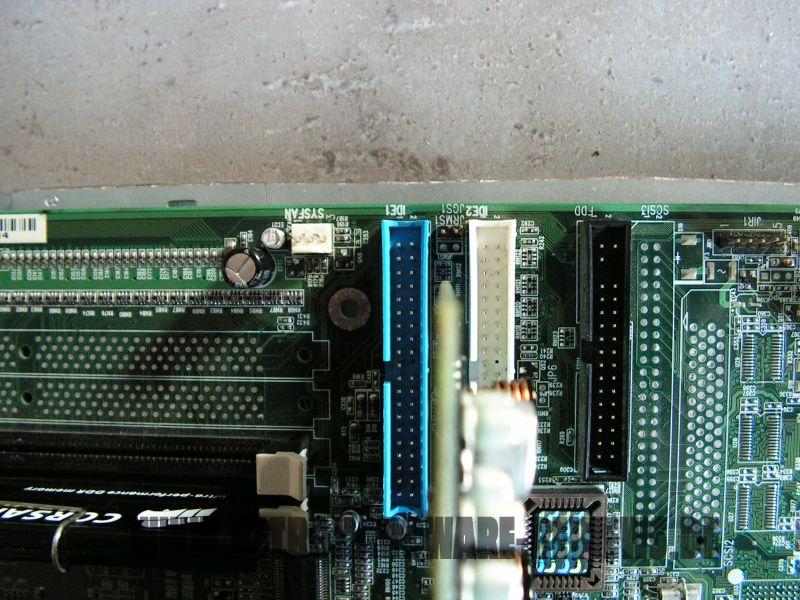
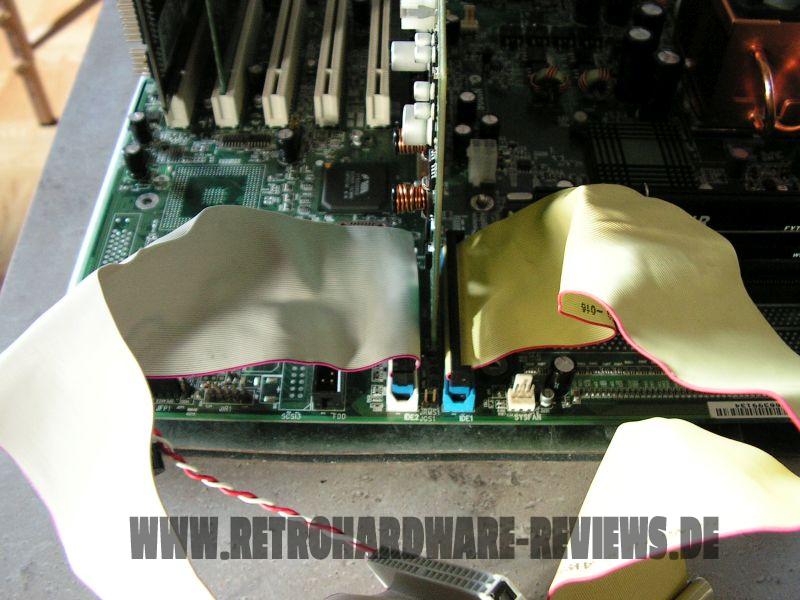

The space around the CPU socket is sufficient for all kinds of large coolers, even though the tall capacitors below it can make it hard to install coolers with a 3-lug clamp. Unfortunately the CPU socket is also placed pretty close to the top edge of the board, making it impossible to remove the CPU cooler when system is fully assembled.
I tested the following seven coolers towards compatibility:
- Thermaltake Silent Boost K7
- Cooler Master HHC-001
- Swiftech MCX 370
- Alpha PAL 6035
- Alpha PAL 8045
- Smartcooler 60mm
- Arctic Cooling Copper Lite

All of these could be installed, with the Arctic Copper Lite being the exception. It collides with the aforementioned capacitors and even if it wouldn't, the mounting clamp would have been very hard to reach there. The rest of the coolers were relatively easy to install, although the Cooler Masters lever will most likely collide with the PSU in most cases, since it reaches over the top edge of the PCB quite a bit.

Cooler Master HHC-001
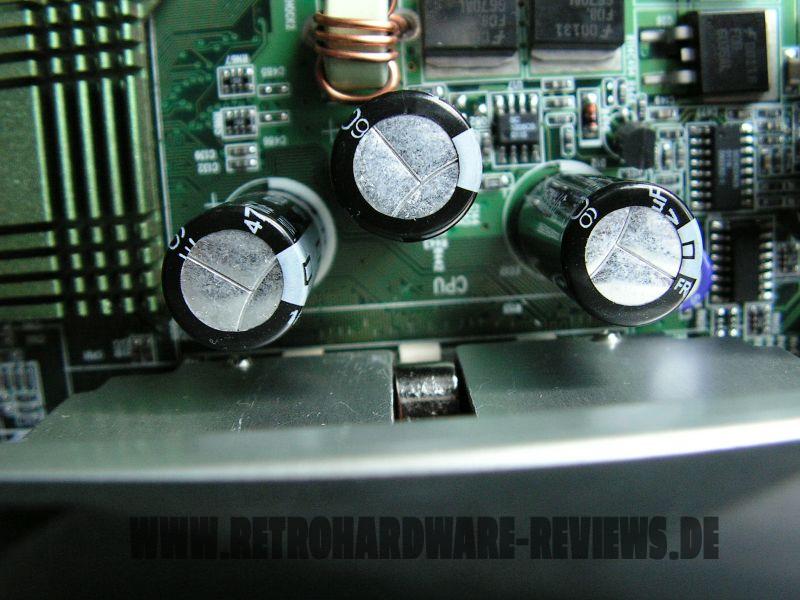
Silent Boost K7
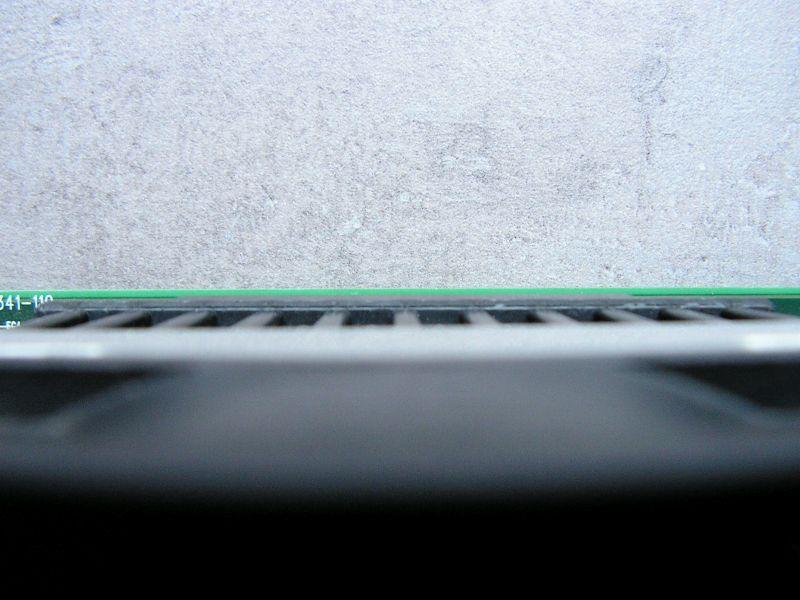
Alpha PAL 8045
Another problem caused by the position of the CPU socket is, that the ATX power cable probably has to be routed below it. Unfortunately, the ATX power connector is located in the upper left corner of the board, and above the CPU socket, there will not be enough space for the cable in most cases. This of course massively affects the airflow, since the cable has to be routed over many hot spots, such as the VRM area and the chipset.


To complete the list of issues, the position of the CMOS battery is also rather bad. Located in the the lower left corner, it gets covered, if an expansion card is installed into PCI #4, which is not exactly unlikely. Of course the lower right quarter of the board is primarily covered (or reserved on the non -S variants) by SCSI connectors and chips, but if the layout was better overall, there would shurely have been a better spot free for the CMOS battery.
On the plus side, we have two 3-pin fan connectors, which are placed pretty well for connecting a fan in the front and in the back, as well as a cool feature that I did not see on any other board yet. The jumper “JP3” lets you reset all CPU and FSB related parameters, without resetting the whole BIOS. This is pretty useful for unsuccessful overclocking attempts and even more so, if the CMOS battery is hard to come by 😉
MSI also included a buzzer on the K7 Master, which can be enabled by shortening the otherwise unused middle-pins of the 4-pin speaker connector. If you leave it open, the buzzer is disabled, so that an external buzzer oder speaker can be connected.
Another useful feature are the Diagnostic LEDs, which can help troubleshoot if the system doesn't POST. It can show various combinations of red and green LEDs, that correspond to different system initialization steps. If all 4 LEDs turn green, the system is ready to boot.


Test-System and Parts
Baseline Setup:
- CPU: AMD Athlon Thunderbird 1200C (FSB133)
Because I want to compare 1st Gen Socket A mainboards to their DDR follow-ups I have to use a CPU, which is available in FSB100 and FSB133 versions with the same clockspeed. Since I sadly don't have a Thunderbird 1400 B at my disposal, I will use the Thunderbird 1200 for my reviews and comparisons of these boards, which I have in the “B” (FSB100) and “C” (FSB133) version.
- RAM: 1x Corsair CMX512-3200C2 (XMS3202v4.2) = 512MB PC400 CL2
This Corsair XMS stick should allow the tightest timings at 266 MHz DDR and its size of 512MB is the perfect choice for Windows 98SE.
- VGA: MSI Geforce 4 TI4200-VTD8X
To remove any GPU bottleneck for testing, I chose a Geforce 4 Ti as the primary graphics card for my test setups. The Geforce 4 Ti series are also known to pull a lot of power from the AGP port, so that possible problems in that department can also be revealed. It is also somewhat period correct and a good match for a high performance retro-machine that should be able to run late Windows 98SE games without any issues.
- VGA2: 3dfx Voodoo 5 5500 AGP
Many people consider the Voodoo 5 5500 the perfect card for (Win9x-) retro gaming. The Voodoo 5 benefits from a beefy setup, so a powerful Athlon Thunderbird or early Athlon XP is the perfect match for this card.
- Audio: Creative Soundblaster Live! (SB0060)
Creative's Soundblaster Live! can be found in many retro-machines. It offers great sound, perfect Win98SE compatibility and is still widely available for reasonable money. It was also known to cause problems with VIA-based 686B southbridges using old BIOS revisions and VIA chipset drivers. All this should be history at this point, but double checking on pontentially affected mainboards is still not a bad thing to do.
- LAN: 3Com Etherlink XL PCI
Just a good, reliable choice for networking. All legacy Windows versions all the way up from Win95 have built-in drivers for it, which is also a huge “plus”.
- HDD: Western Digital WD200BB (20GB 7200RPM)
No special intention behind this drive, it is just “there” and still works fine.
Additional Hardware for certain Tests:
- Silicon Image Sil3512 SATA Controller & Samsung PM871 128GB SSD
These two will help me measure the PCI bandwidth.
- Hitachi Deskstar T7K500 (500GB 7200RPM)
This drive will tell us, how big we can go with the onboard IDE connectors and how the performance is like.
- 2x Voodoo 2 12MB (SLI)
A pair of Voodoo 2s is a must have for any retro-machine, that doesn't feature a 3dfx card as the primary VGA solution. They offer compatibility to older Glide games and can be used with any more powerful primary graphics card. It is an important thing to know, how well these perform and if there are differences between all the available Socket A chipsets of that era or even between boards using the same chipset.
Drivers used:
- Chipset: AMD AGP Miniport 4.80 + VIA Hyperion 4in1 4.56v (without the AGP drivers)
- Geforce 4: nVidia Forceware 43.45
- Voodoo 5: Amigamerlin 2.9
- Voodoo 2: FastVoodoo 4.6
- SB Live!: Some driver from my archive, not shure 😉
- 3Com NIC: Windows 98SE preloaded driver
- SATA Controller: Some driver from my archive, not shure 😉
System Setup and Usage
The initial setup of the K7 Master is really easy. If a new CPU installed, the BIOS automatically boots with FSB100 and asks you to set the appropriate parameters for your CPU in the BIOS. This is at least true, if the BIOS is completely reset. If a CPU is installed that does not work with the settings of the previously installed CPU, the system doesn't POST.
But you don't have to reset the BIOS completely, you can reset all CPU related parameters with the aforementioned “JP3” jumper instead, which then lets the system POST with all CPU parameters to default and FSB100. Quite a nice feature for failed OC attempts actually (at least for that time).
In contrary to the overall OC settings vailable, there are quite a number of memory-related settings available. I was able to configure the main timings to CL2 2-2-4, and the system was perfectly stable in this configuration.
So, after the CPU and memory setup was through, I went on to the installation of the expansion cards. Thankfully, the K7 Master's manual made this matter a simple task (so I thought), as it features a perfect explanation on how the INT routing and PCI ↔ onboard device sharing is organized on the K7 Master:

Unfortunately, the sharing itself is not on the same level as the documentation about it. The AGP port is shared with PCI #2, which more or less makes two of the five PCI slots unusable (PCI #1 should generally be left free for the AGP card's ventilation).
But since I experienced in previous reviews, that the SB Live! works best most most of the time, when it's plugged into the PCI slot that is normally shared with the onboard audio, I decided to install it to PCI #3. Subsequently, the 3Com NIC had to go into PCI #2 (sharing an IRQ with the AGP card), because I need two neighboring slots for the Voodoo 2 cards. So my first stup looked like this:
- PCI #1: free
- PCI #2: 3com NIC
- PCI #3: SB Live!
- PCI #4: Voodoo 2
- PCI #5: Voodoo 2
In this configuration, however, the NIC wasn't detected at all. Since I wanted the SB Live! to definitely be kept sharing-free, the only other possible slot for it was PCI #5, so I changed the setup as follows:
- PCI #1: free
- PCI #2: Voodoo 2
- PCI #3: Voodoo 2
- PCI #4: 3Com NIC
- PCI #5: SB Live!
This time, all devices got detected fine, and the driver installations went without any problems. But after I installed all devices, there was still an unknown device in the device manager. I don't know what that is, it might be some kind of monitoring chip or something, but there are no drivers other than chipset, SCSI controller (which I don't have on my board) and audio chip available for download on the MSI support site. At least it doesn't allocate an IRQ, since PCIlist.exe does not list it. And because I got all required devices installed and everything worked fine, I just left it alone and went on with the benchmarks, which all completed without issues.
Benchmarks
Synthetic Measurements
Before we get into the 3DMark and gaming benchmarks, let's have a look at some theoretical numbers. These synthetic tests will exhibit the differences between the several chipsets and boards better than any game benchmark and provide us with "background information" that might be of use in understanding the timedemo results later.
Memory Performance: AIDA64 Cache & Memory Benchmark
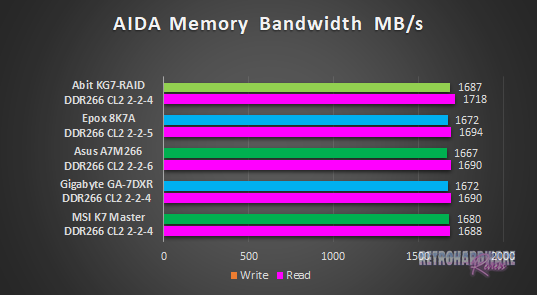
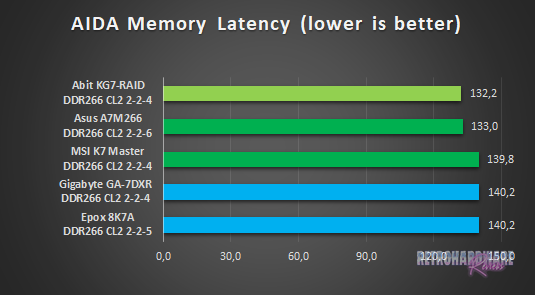
While the K7 Master ranks last in the chart (because of its slightly lower read throughput), it shows the second highest write bandwidth and its read performance is also very close to that of the three boards ahead of it.
In the memory latency test, it ranks third with a tiny advantage over the boards trailing it, but a major distance to the two boards in front.
Application Performance: 7-Zip
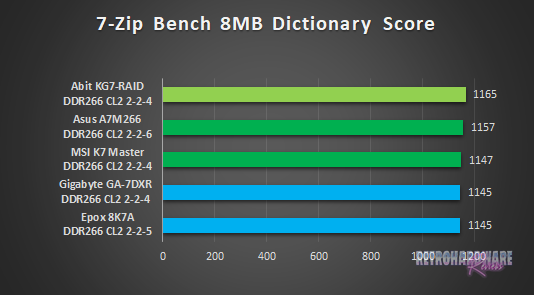
The MSI Board takes third places, again slightly faster than the EpoX 8K7A and Gigabyte's GA-7DXR, like in the memory latency test before.
AGP Performance: Final Reality Benchmark
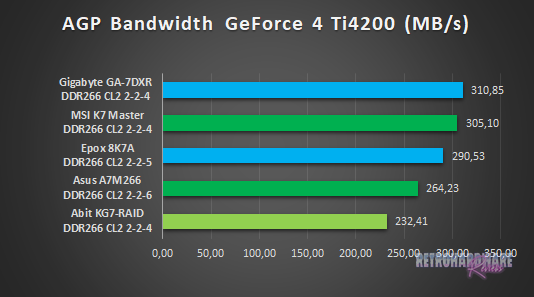

AGP bandwidth on the K7 Master is looking good, it takes second place for the GeForce 4 Ti measurements, very close to the top performing GA-7DXR and third place with the Voodoo 5 installed.
AGP and PCI Performance: 3DMark 2000 and ATTO
3DMark 2000 as a whole is very focused on TnL and is by far not as interesting for retro-hardware comparisons as its predecessor. Its “High Polygon Count, 1 Light” test, however, is another good way to measure the AGP performance. In opposite to the Final Reality test, the general system performance is also somewhat of importance. The benchmark was executed with the Geforce 4 Ti installed.
To measure PCI performance, I installed a Windows 98SE compatible SATA controller with a Samsung PM871 128GB SSD connected into the system. For the bench, I chose 1024 to 4096 KB block size and picked the overall best values for the read and write throughput. This test will show, which maximum performance can be expected with fast storage options like SATA or SCSI and maybe gives a hint, if the chipset might be good for Voodoo 2 cards.
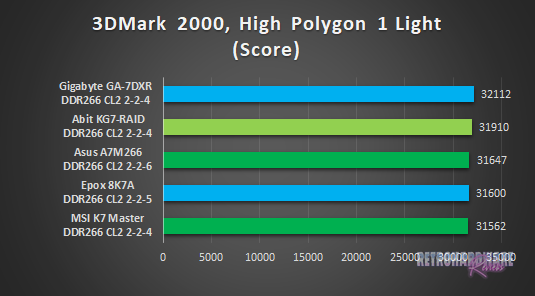
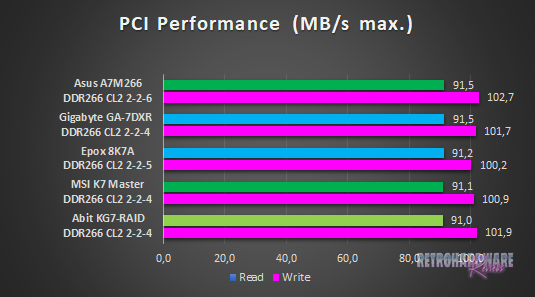
The reuslts for the 3DMark2000 sub-test look rather disappointing, considering the good AGP bandwidth shown before. The K7 Master takes last place here.
It also achieves the second lowest PCI bandwidth values for both read- and write throughput, but the performance is still excellent and perfectly suited for any kind of bandwidth-demanding PCI expansion cards and storage options.
Storage Performance: HDTach
To measure the performance of the board's IDE and (if available) onboard IDE RAID solutions' performance, I benched one of the latest and fastest IDE drives (the Hitachi Deskstar T7K500 500GB) with the HDTach benchmark. I also tried a much more “recent” drive (the Western Digital Blue Edition 500GB), which should be even faster in theory, but the Hitachi drive produced much better results in this test.
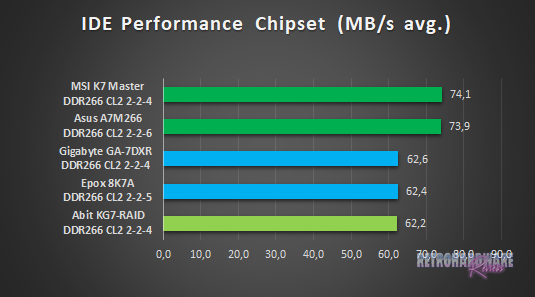
The IDE performance is the best among the participants, with a slight 0,2 MB/s advantage over the second-placed Asus A7M266.
Gaming Benchmarks
Now that we got all the theoretical performance numbers, let's see how the contenders perform in 3D gaming benchmarks.
3D Performance: 3DMark99max
3DMark99max was released in early 1999 and comes without support for Hardware TnL. The maximum supported (hardware-) DirectX level is DX6. It is a great benchmark to reveal good overall system performance, as it rewards good memory bandwidth and latency more than the slight clockspeed advantage, that some boards have because of their factory-overclocked FSBs.
- Version: "latest"
- Settings: standard
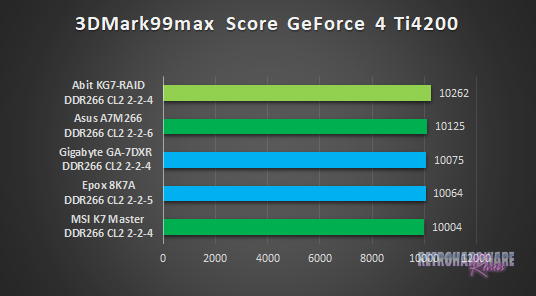
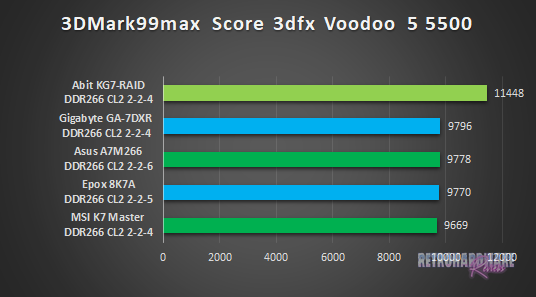
Although the difference to most other boards is not tremendously big, the K7 Master takes the last place in 3DMark99max with both the GeForce 4 Ti and the Voodoo 5.
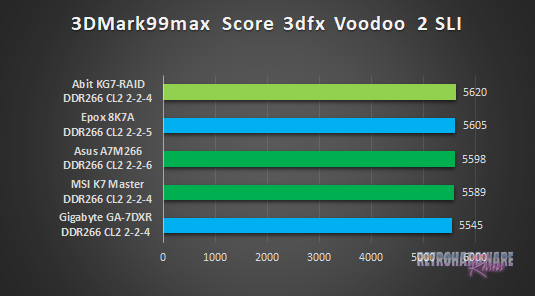
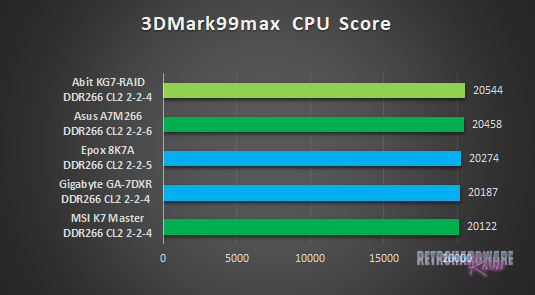
The 3DMark99max CPU score of the MSI board is also the lowest in the field, but with the Voodoo 2 cards in SLI, it achieves fourth place with a score pretty close to the three boards ahead of it.
3D Performance: Unreal Tournament (UT99) Timedemo(s)
Unreal Tournament (UT99) was released in November 1999 and is notorious for its hunger for CPU power. I chose to use two different timedemos for comparison, of which the utbench.dem timedemo is heavily CPU bound and therefore qualifies to measure the general performance of the boards. The second timedemo benchmark.dem is as GPU limited as possible in this game. This will reveal, how much impact a faster board can still have in more GPU limited situations. This game is also perfect to show, on which chipsets and boards Voodoo 2 cards run best.
- Version: 4.36
- Settings: High, Min desired Framerate "0", Show Decals [x], Use Dynamic Lightning [x]
- Geforce: D3D
- Voodoo 2 and Voodoo 5: Glide
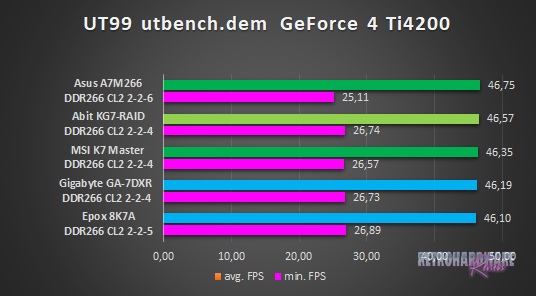
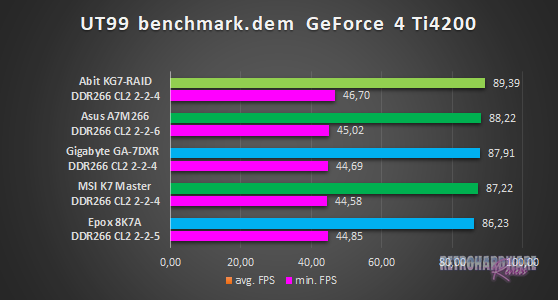
In the utbench timedemo, the K7 Master ranks third, with performance in line with the other boards, which all perform very similar. In the second timedemo, the MSI board falls behind a little, showing the lowest minimum framerate and the second lowest average FPS of all boards.
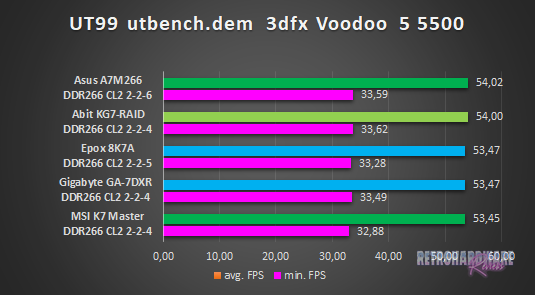
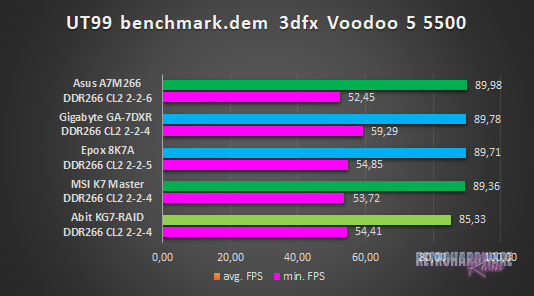
The MSI board ranks last in the utbench timedemo and second to last in the benchmark.dem timedemo. Like in the GeForce 4 Ti runs before, the performance is not much lower than shown by the other boards, but still more on the low side in comparison.
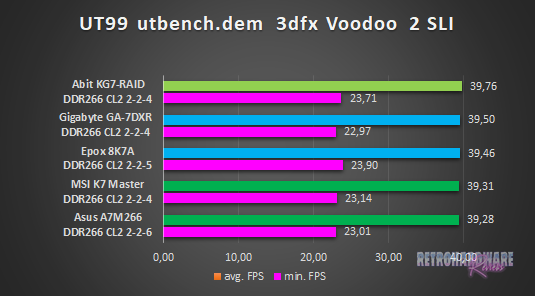
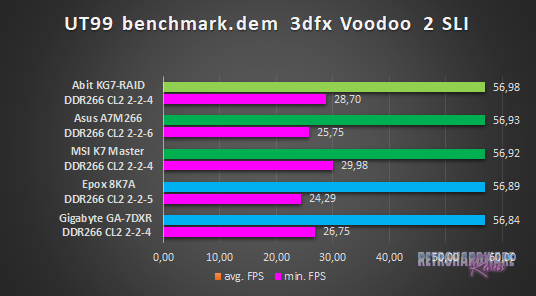
Average framerates are fairly equal across the board in the first timedemo, but the boards can roughly be divided into two groups based on the minimum FPS achieved. The K7 Master falls into the "slower" group, along with the Asus A7M266 and Gigabyte's GA-7DXR.
However, it is the secret winner of the benchmark.dem timedemo, with the strongest minimum FPS by far, while the average framerates are about the same for all boards.
3D Performance: Quake III Arena Timedemo
Quake 3 Arena was released shortly after Unreal Tournament, in December of 1999. It is known to reward fast memory latency and with its normal preset, it is completely CPU limited; at least for the GeForce 4 and the Voodoo 5. The Voodoo 2 SLI cards clearly limit the Athlon 1200 here, as the timedemo will show.
- Version: 1.32
- Settings: “Normal” Preset, only resolution changed to 1024x768x16
- Geforce 5 and Voodoo5: OpenGL
- Voodoo 2: “Voodoo” Renderer (miniGL)
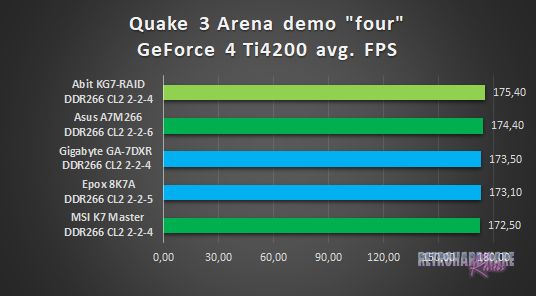
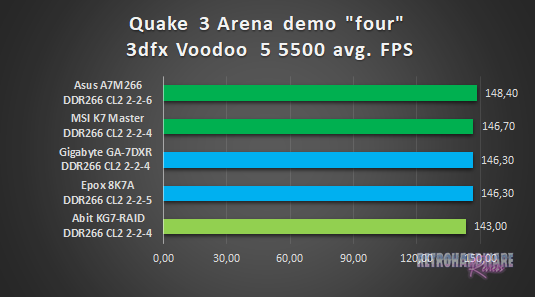
In the Geforce 4 Ti run of the Quake III Arena, the K7 Master is once again the slowest board, but it ranks a solid second with the Voodoo 5 5500 installed.
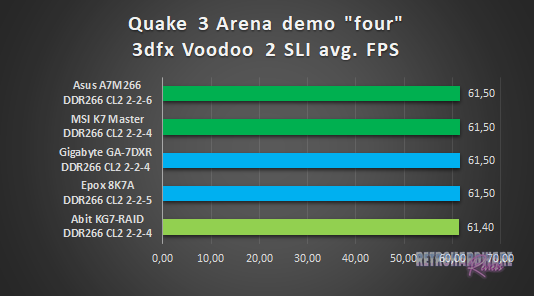
The Voodoo 2 SLI setup clearly limits here. All boards score the same FPS, with only the Abit KG7-RAID a close 0,1 FPS behind.
Summary & Rating
MSI K7 Master (MS-6341) (AMD760)
-
Layout
-
Features
-
Overclocking Options
-
Compatibility
-
Documentation & Support
-
Performance: GeForce 4 Ti 4200
-
Performance: Voodoo 5 5500
-
Performance: Voodoo 2 SLI
OVERALL
| Pros | Cons |
| + Fantastic PCI performance | – Many layout shortcomings |
| + Diagnostic LEDs | – Only two memory slots |
| – Tall capacitors close to CPU socket |





